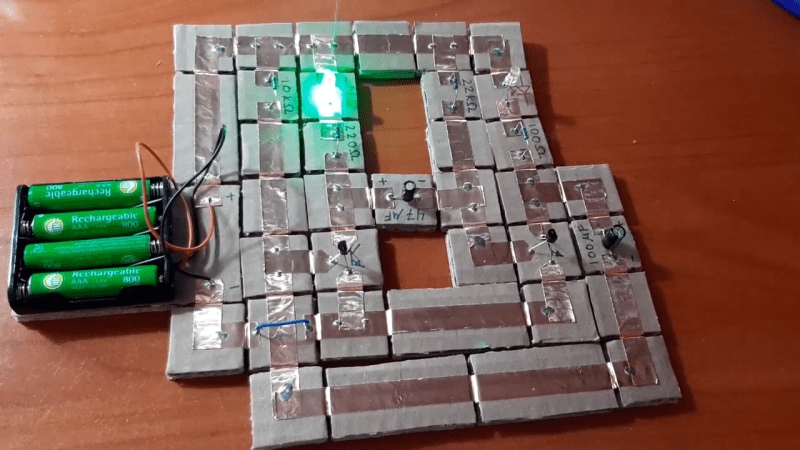Let’s face it, breadboarding can be frustrating, even for advanced electronics wizards. If you have an older board, you could be dealing with loose tie points left from large component legs, and power rails of questionable continuity. Conversely, it can be hard to jam just-made jumper wires into new boards without crumpling the copper. And no matter what the condition of the board is, once you’ve plugged in more than a few components, the circuit becomes hard to follow, much less troubleshoot when things go pear-shaped.
In the last twenty years or so, we’ve seen systems like Snap Circuits and Little Bits emerge that simplify the circuit building process by making the connections more intuitive and LEGO-like than even those 160-in-1 kits where you shove component legs between the coils of tight little springs. You will pay handsomely for this connective convenience. But why should you? Just make your own circuit blocks with cardboard, magnets, and copper tape. It should only cost about 10¢ each, as long as you source your magnets cheaply.
[rgco] gives the lowdown on building a minimal set of 23 component and connector blocks using 100 magnets. He’s got 11 example circuits to get you started, and some example videos of more advanced circuits that got tacked up after the break.
This method of making the circuit look more like the schematic may be the best way for the visually-inclined to learn electronics. But the best way to learn electronics depends on where you’re coming from.

















I’ll just stick with my breadboard for(ever) now, thanks for the new….er idea?
Cool yes, attractive – not at all.
A rather cheap source for magnets I use: If you are a smoker and roll your own cigarettes: Gizeh/Marie papers contain small magnets: remove them (its better anyway, you could recycle the rest as paper trash) and reuse:
-) Put them in a 3d printed case: magnetic tool holder
-) Use it with reed relays
-) At the university, we used it to mount the part holders in our PnP machine
One big disadvantage: 100papers (cigarettes) for each magnet ;-)
This technique might suit very well to educatioan purposes, providing basic electronic skills.
For prototyping, the breadboard and even cheap pcb services are far more adequate.
Back in the 1970’s my dad got me an electronics set that worked on exactly this principle. It came with a metal base that served as the ground plane. I spent a lot of hours playing with this stuff, it was pretty fun. It was one of these:
https://en.wikipedia.org/wiki/Raytheon_Lectron
Yip!
Had it…
Two expensive sets of it.
It was fun for a while, then contact problems made it unusable!
I didn’t even dare to give it away, it ended in the trash.
:-(
I still have mine from the late 60’s
I had the german variant as a kid and it was awesome.
Made my first radio receiver and transmitter on it, among other things.
I love the out of the box thinking here,
But for experiments with that new super-sensitive-MAGNETIC-sensor thingy from ebayexpressmazon… I rather use the conventional breadboard setup.
It is sub-optimal routing and might not be able to connect in some cases as you can’t have connections crossing over.
There are cross-over junction pieces, but the main issue is still the large number of simple connection blocks you need to build even the simplest circuit.
I’d rather have a small tape dispenser that gives out narrow copper foil tape. Like a dotliner:
https://www.kokuyo.co.jp/com/press/2005/05/page_img/20050519_01.jpg
For prototyping circuits with discrete components, nothing beats the speed of simulation. LtSpice, and even the analog circuit simulator applet at http://www.falstad.com/mathphysics.html
(if you can run Java applets), are useful for toying around with simple components.
Beware not all parameters of semiconductors may be simulated like the breakdown voltage of the collector, but simulation can provide a good quick way to test out basic transistor circuits.
It’s been Javascript for a couple of years now.
Let’s see an IC with 8 or more legs wired up with this system then… ;-)
Like Snapcircuits this idea takes lots of space as complexity grows. Has been done in several ways historically. Not ‘bump’ resistant and prone to bad connections. Has been said Magnets can be detrimental to certain circuit operations. Im assuming educational use.
Ye ol springy wire connectors are overly tested, proven, time and use worn, child survived to adult to generations reliable. Snap-circuits and that other thing not so much. Fortunately worn out snaps are replaceable but circuits not easily modified for experimentation once built. Layered circuit approach can be bothersome for some as well. That other thing is a bus driven overpriced module system. Doesnt really teach electronics but can be used for limited prototyping without much in the way of knowing how the modules work. More of a modular programming environment.
The springy numbered point to point system is considerably less prone to error. Provides a procedural path for troubleshooting. Follow the numbers and circuit path. Just like service manuals and schematics.
Components secured on board make it hard to lose anything. Exception to runaway wires that destroy vacuum belts directly or by wrapping around beater bar axel. :) Easy to move a wire or entire circuit for experimenting. Multiple tie points and paths. Is bump resistant. Connections are reliable. Not wire chewing kitty reliable but good. Solderless breadboard is a step up requiring more dexterity and of need .10 pitch capable components.
The predecessor to the spring was push down clip which also worked well.
Ahhh first prattle of the new year for me.
I remember the version from the 1960’s. It was ideal for simple radio and transistor circuits. Very impractical for integrated circuits… which is likely the primary reason the system died out.